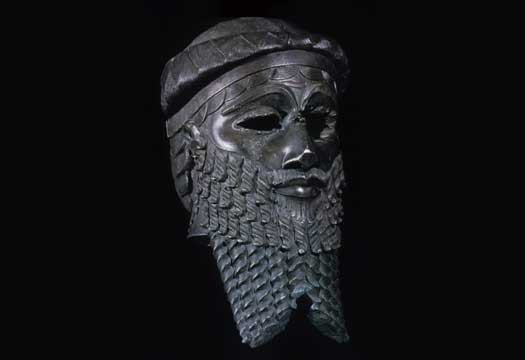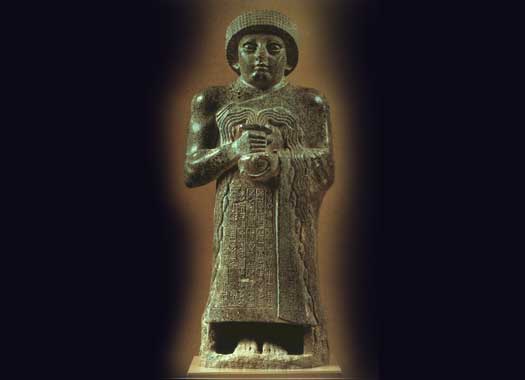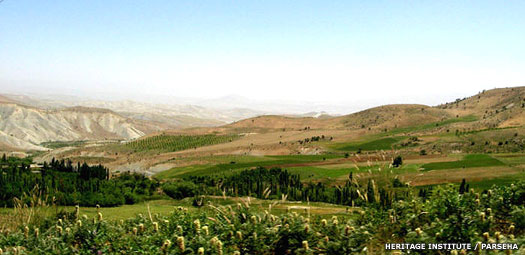
| GUTIANS / GUTIUM The Gutians (Guti, or sometimes Quti) were one of a number of people who formed the population of ancient Mesopotamia. They occupied the central Zagros Mountain range from the last few centuries of the third millennium BC onwards, but nothing concrete is known about their origins. They were not a tribe, as is often stated, simply a collection of nomads who settled together and were later branded under a single name.
For around a generation they appeared in increasing numbers in Sumer and Akkad as settlers, to the extent that they required the royal appointment of an interpreter in Adab. The general region into which they settled became known as Gutium (although there was no single, fixed location by that name), but the settlers themselves came to be referred to as the 'Guti Hordes', as they remained anything but settled and productive new neighbours. Shortly after about 2200 BC they swept down in force into southern and central Mesopotamia, destroying the Akkadian empire at Agade, and subjugating much of Sumer either directly or indirectly. Their numbers by this stage must have been impressive, as the city states of Mesopotamia were long used to fighting tooth-and-nail for regional domination, and Akkad had become the biggest and strongest of them all.
The Gutians based themselves near the ruins of Agade at the northern edges of Sumer and pretty much due west of their Zagros Mountain settlements. The cities in the south were able to enjoy a certain level of freedom, and were able to manage their own affairs to an extent. The Gutians proved to be very poor rulers of Sumer, however. They were crude administrators, clearly not at all used to the complexities of managing an urban society. Prosperity declined alongside proper organisation, particularly in connection with the canal network. This was allowed to sink into disrepair, with famine and death resulting as crops failed. A short dark age swept over Mesopotamia as a result of their arrival and dominance. It was inevitable that they would be ejected.
The questions surrounding Gutian origins have long existed. They may have been an Indo-European people, although assigning them to any specific group of Indo-Europeans requires some degree of speculation as they arrived too early to be part of any of the usual waves of Indo-European migration. There is the possibility, according to some areas of scholarship (W B Henning especially), that they were linguistically related to Tocharians (who ended up settling around the Altai Mountains to the north-west of ancient China - see feature link, right). This, though, would require an early split from the main group of proto-Tocharians which itself split away very early from the main Indo-European collective (something like 4000-3500 BC). Access to the Near East at this time can only have been via the Caucuses and eastern Anatolia, as the later route for Indo-Aryans was still blocked by the Bactria-Margiana Archaeological Complex. The length of time between split and arrival suggests a long sojourn in Anatolia itself.
That Anatolian route raises the possibility that they were part of - or had travelled ahead of - the second division of Indo-Europeans in the form of the Anatolian branch (see feature link). This would also produce unique elements of language that would not be seen in the main collective. The Gutians have also been linked to the 'Qutils', a group that has in turn been linked to the Mitanni of the subsequent millennium, and to the modern-day Kurds as the descendants of these ancient groups who occupied the same general territory. However, the names of Gutian rulers that are shown below exhibit almost no apparent Indo-European influence barring two names, those of Inkishush and Iarlaganda. If the bulk of the Gutians were Indo-Europeans then they were almost certainly being dominated by a non-Indo-European elite.
According to the Sumerian king list, a total of 21 kings (MS P4+Ha has 23) ruled for 125 years and 40 days (MS P4+Ha has 99 years), once (one dynasty) in the army of Gutium. This is the seventeenth set of entries on the list comprising kings 98-118. Here, List 1 is primarily used (with names in black in the list below), backed up by List 2 (names in green) and List 3 (names in red - see Sumer for further details). Dates are calculated back from circa 2120 BC, when the Gutians were ejected, and may not be entirely accurate.
(Information by Peter Kessler, with additional information by Edward Dawson, from The Sumerians: Their History, Culture, and Character, Samuel Noah Kramer (List 1 of Sumerian rulers, Phoenix Books, 1971), from The Horse, the Wheel, and Language: How Bronze-Age Riders from the Eurasian Steppes Shaped the Modern World, David W Anthony, from Historical Atlas of the Ancient World, 4,000,000 to 500 BC, John Haywood (Barnes & Noble, 2000), from Mesopotamia: Assyrians, Sumerians, Babylonians (Dictionaries of Civilizations 1), Enrico Ascalone (University of California Press, 2007), from The First Empires, J N Postgate (Oxford, 1977), from A History of the Ancient Near East c.3000-323 BC, Marc van der Mieroop (Blackwell Publishing, 2004, 2007), from The Sumerian Kings List: Translation, J A Black, G Cunningham, E Fluckiger-Hawker, E Robson, and G Zólyomi (List 2 of Sumerian rulers, via The Electronic Text Corpus of Sumerian Literature, Oxford, 1998), from Earth's Ancient History: A Theory About Ancient Times, L C Gerts (List 4 of Sumerian rulers, Chapter 12: The Sumerian king list, 2002), from Indo-European Etymological Dictionary, J Pokorny (online database which updates Pokorny's Indogermanisches Etymologisches Wörterbuch), and from External Links: Ancient Worlds, and Ancient History, Anthony Michael Love (List 3 of Sumerian rulers at Sarissa.org (dead link), and Peering at the Tocharians through Language (Borderless Blogger), and The United Sites of Indo-Europeans, and Linguistics Research Center (University of Texas at Austin), and Indo-European Chronology - Countries and Peoples, and Indo-European Etymological Dictionary, and Encyclopaedia Iranica.)
c.2350 BC :
The short-lived empire of Lugalannemundu of Adab subjects the Gutians. The latter can only recently have arrived in the Zagros Mountains and have been settling the less hostile areas, probably in a series of small, interconnected settlements which nevertheless would seem to be able to muster enough of a military threat that the more established city states feel they need to impose control over them.
The Sumer into which the Gutians gatecrashed was formed by a complex network of city states and canals fl c.2300 BC :
Sarlak : Ruled in the Gutian mountain homelands.
Sargon of the Akkadian empire claims to be the first king to unite Mesopotamia (Sumer and Akkad), although Enshakushanna of Uruk has already achieved that. However, his many campaigns include one feat not achieved before, mounting seemingly successful attacks against the Gutians who are being lead by their ruler, Sarlak.
fl c.2220 - 2211 BC :
Eridu-pizir : Not on the king list. Claimed inheritance of Akkadian titles.
c.2210 BC :
Marhashi overruns Elam for a time, and unites eastern efforts in fighting against the Akkadian empire. A battle is fought near Akshak, at the confluence of the Diyala and Tigris rivers between the two states. One of the Marhashi ruler's daughters is married to Sharkalisharri of Agade or his son, perhaps as a consequence of the battle, and as a sign of renewed ties of peace.
The episode, though, may be a sign of growing Akkadian weakness, although the Gutians are not yet in a position to take advantage. Eridu-pizir is shown on inscriptions as the Gutian who loses domination over the Lullubi of northern Mesopotamia.
Sargon the Great, the warrior king of apparently humble origins, unified Sumer for the first time in recorded history through a series of campaigns and the defeat of the current holder of Sumer's equivalent of a high kingship fl c.2216/15 BC :
(Nameless king) / (No king was famous) : Ruled for ?/3/5/4 years.
fl c.2211 BC :
Imta / (No data) : Ruled for 3 years.
Inkishush / Inkicuc / Inkishu : Ruled for 6/7 years.
fl c.2208 BC :
The
name Inkishush has the appearance of being of Indo-Aryan origin.
The first part, 'ink-', may be cognate with 'ang-', and therefore
with the Norse name, Ingo, via the early Germanic links with satem-speaking
East Indo-Europeans. Those same satem-speaking Indo-Europeans may
be having a minor impact here, although specifics are unavailable.
fl c.2202 BC :
Sarlagab / Zarlagab / Nikilligab : Ruled for 6 years.
fl c.2196 BC :
Shulme / Culme / Yarlagac : Ruled for 6 years.
c.2193 BC :
The Gutians overthrow Elam and sweep through Sumer, effectively destroying the Akkadian empire, and ending Sumerian/Akkadian domination of the region. They also defeat Uruk, with Sumerian records stating that they carry off the kingship (in other words, that they are the dominant force). Sumerians view them as being uncouth foreign barbarians.
Both Sumer and Egypt endure a short dark age at this time which would seem to be climate-induced, indicating that the city states are weak at this time anyway. Very little is known about Akkad until around 2100 BC. It is from this point that the Gutian kings are recorded in more detail (although some lists place Shulme after Imta, missing out Inkishush and Sarlagab).
A figurine of Gudea of Lagash, who came to prominence in southern Mesopotamia, for the most part outside of direct Gutian rule but still subject to its influence The king list now states: 'Who was king? Who was not king? Igigi the king; Nanum, the king; Imi the king; Elulu, the king - the four of them were kings but reigned only three years' (see the rump post-Gutian state of Agade, as these all rule briefly there as civil war apparently grips the city). In the north the Hurrians arise as a notably separate group which begins to dominate the upper Tigris Valley and the upper Euphrates.
fl c.2190 BC :
Elulumesh / Silulumec / Silulu : Ruled for 6/7 years.
fl c.2184 BC :
Inimbakesh / Inimabakec / Duga : Ruled for 5/6 years.
fl c.2179 BC :
Igeshaush / Igecauc (or Ilu-an?) : Ruled for 6 (or 3) years.
fl c.2173 BC :
Iarlagab / Yarlagab : Ruled for 15/5 years.
fl c.2158 BC :
Ibate : Ruled for 3 years.
fl c.2155 BC :
? / Yarla / Yarlangab? / Iarlagash : Ruled for 3 years.
fl c.2152 BC :
Kurum : Ruled for 1/3 years.
fl c.2151 BC :
? / Apil-kin : Ruled for 3 years.
fl c.2148 BC :
? / La-erabum? : Ruled for 2 years.
fl c.2146 BC :
Irarum : Ruled for 2 years.
fl c.2144 BC :
Ibranum : Ruled for 1 year.
fl c.2143 BC :
Hablum : Ruled for 2 years.
fl c.2141 BC :
Puzur-Sin / Puzur-Suen : Son. Ruled for 7 years.
c.2138 BC :
The city of Kissura (the modern archaeological site of Tell Abu Hatab) establishes its own kingship for the first time, after around six hundred years of occupation of the site and dominance by larger cities around it. This break from its traditional position may be a result of weakening Gutian influence in the region. Gudea of Lagash (an interesting figure with the 'gut-' of Gutian in his name) also rises to prominence in the south, but probably still subject to Gutian influence.
The Zagros Mountain range provided the Gutians with their home, from their assumed arrival in the region around the period between 2450-2350 BC onwards, as it did the later Medes and Persians fl c.2134 BC :
Iarlaganda / Yarlaganda : Ruled for 7 years. Indo-Aryan name influences?
fl c.2127 BC :
? / Si'um / Si-u : Ruled for 7 years. Name found on inscription.
fl c.2120 BC :
? / Tiriga / Tirigan : Ruled for 40 days. Gutians ejected from Sumer.
c.2120 BC :
Utuhegal,
king of Erech (Uruk) throws out the Gutians once and for all, claiming
the kingship. Seemingly unable to retaliate or so broken that they
have been destroyed as a fighting force, they retreat back into
the mountains.
c.1764 BC :
A major invasion of southern Mesopotamia by a coalition army of Elamites, Assyrians, Gutians and Eshnunnians is defeated and crushed. The region sinks into historical obscurity for many centuries, but later provides a home to new arrivals such as the Mannaeans, Medes, and Parsua. During the seventh century BC, it is conquered by the Cimmerians, who are acclaimed by Assyria as rulers of 'Qutium' (Gutium - same name, perhaps slightly different pronunciation or writing style).
During the sixth century BC Gutium it appears to be a district or province of the Babylonian empire, and following conquest by the Persians in 539 BC it seems briefly to be governed by the aged General Ugbaru, following his part in turning Babylonia into the Persian satrapy of Babirush (it has been the case in the past that this Ugbaru has been identified as the first satrap there, but see Satrap Gaubaruva for an examination of this). The Gutians survive as a recognisable group - despite the term evolving into a more generalised branding for any group of hostile barbarian - but they never again amount to anything of consequence.
Source :
https://www.historyfiles.co.uk/ |



